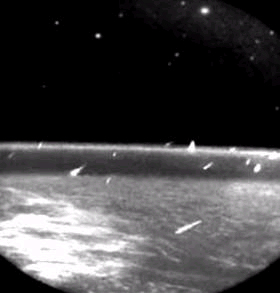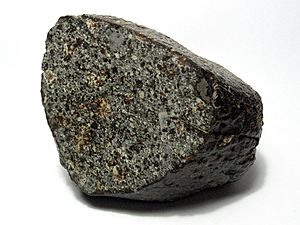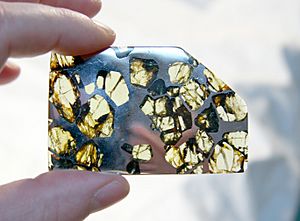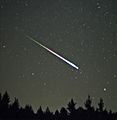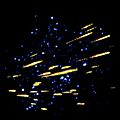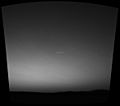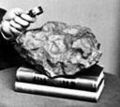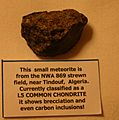Meteor facts for kids
Have you ever seen a bright streak of light flash across the night sky? That's a meteor! People often call them "shooting stars" or "falling stars." Most meteors are faint, but some can be very bright. They happen when a piece of space rock enters Earth's atmosphere.
If a space rock hasn't reached our atmosphere yet, it's called a "meteoroid." These can be as big as large rocks or as tiny as dust particles. When meteoroids hit Earth's atmosphere, they are usually moving incredibly fast. This speed makes them heat up a lot and often break apart. The heat makes them glow, and that's when we see them as meteors.
Meteors are different from comets or asteroids. However, some meteors, especially those we see during a meteor shower, are tiny dust particles that came from comets.
Sometimes, a meteoroid is big enough to survive its fiery trip through the atmosphere and hit the ground. When it lands, it's called a meteorite. A very large meteorite can even leave a big hole in the ground called a crater.
Meteorites come in different types. The main ones are stony, carbonaceous chondrites, and iron-nickel. Stony meteorites look like regular rocks. Carbonaceous chondrites have a lot of carbon. Iron-nickel meteorites are mostly made of iron, often with some nickel mixed in.
Long ago, many meteorites hit Earth during a time called the Late Heavy Bombardment. Today, it's rare for them to cause harm, but it can happen. The Chelyabinsk meteor event in Russia in 2013 caused some damage. Very large meteorite impacts might have even played a part in some of the big extinction events in Earth's history, changing how life evolved.
Contents
Types of Meteorites
Chondrites: Ancient Space Rocks
Chondrites are stony meteorites that are incredibly old. They are as old as our Solar System itself, about 4.55 billion years! These special meteorites sometimes contain amino acids and other organic molecules, which are the building blocks of life.
Chondrites haven't changed much since they first formed. They are made from dust and tiny grains that came together in the early solar system to create small asteroids. They are the most common type of meteorite to fall on Earth, making up about 85% to 86% of all meteorites found.
Studying chondrites helps scientists learn about the beginning and age of the Solar System. They also give us clues about how organic compounds formed and even the origin of life on Earth, or if water was present here long ago. You can tell chondrites apart from iron meteorites because they have very little iron and nickel.
Achondrites: Melted and Changed
About 8% of meteorites are achondrites. These meteorites show signs that they were melted and then cooled down again. They often look similar to rocks found on Earth, like basalt or granite.
Iron Meteorites: Metal from Space
Iron meteorites are made mostly of an iron–nickel alloy. They make up about 6% of all meteorites. These metallic rocks come from the inner cores of small, early planets that broke apart.
Before people learned how to get iron from Earth's rocks, the iron found in iron meteorites was one of the first sources of usable iron. This discovery helped start the Iron Age, a time when humans began using iron tools. Iron meteorites are often easy to find because pure iron is rare on Earth.
Siderolites: Half Stone, Half Metal
Siderolites are a very rare type of meteorite. They are made of almost equal parts iron and silicates (rocky material). Only about 1% of all meteorites are siderolites.
Related pages
| The Solar System | |||||||
|---|---|---|---|---|---|---|---|
|
|
|||||||
| Sun • Heliosphere |
Planets ☾ = moon(s) ∅ = rings |
Mercury | Venus | Earth ☾ | Mars ☾ | ||
| Jupiter ☾ ∅ | Saturn ☾ ∅ | Uranus ☾ ∅ | Neptune ☾ ∅ | ||||
| Dwarf planets | Ceres | Pluto ☾ | Haumea ☾ | Makemake | |||
| Eris ☾ | |||||||
| Small Solar System bodies |
Asteroids (minor planets) |
Groups and families: Vulcanoids · Near-Earth asteroids · Asteroid belt Jupiter Trojans · Centaurs · Neptune Trojans · Asteroid moons · Meteoroids · Pallas · Juno · Vesta · Hygiea · Interamnia · Europa |
|||||
| See also the list of asteroids. | |||||||
| Trans- Neptunians |
Kuiper belt – Plutinos: Orcus · Ixion – Cubewanos: Varuna · Quaoar · Huya |
||||||
| Scattered disc: Sedna | |||||||
| Comets | Periodic comets and non-periodic comets Damocloids · Oort cloud |
||||||
| See also the list of solar system objects | |||||||
Images for kids
-
Meteor seen from the site of the Atacama Large Millimeter Array (ALMA)
-
A meteoroid of the Perseids about ten millimetres in size entering Earth's atmosphere.
-
A meteor from the Leonid meteor shower; showing the meteor, afterglow, and wake.
-
Multiple meteors photographed during a meteor shower over an extended time.
-
A meteor (center) seen from the International Space Station.
-
A possible meteor (center) photographed from Mars by MER Spirit.
-
Comet Shoemaker–Levy 9 colliding with Jupiter: A sequence showing fragment W turning into a fireball.
-
Two tektites, which are melted Earth rocks from a meteorite impact.
-
A partial slice of the Esquel pallasite.
-
The Willamette Meteorite, found in Oregon, USA.
-
A meteorite that fell in Wisconsin in 1868.
-
A meteorite with brecciation and carbon inclusions from Tindouf, Algeria.
See also
 In Spanish: Meteoro (astronomía) para niños
In Spanish: Meteoro (astronomía) para niños


